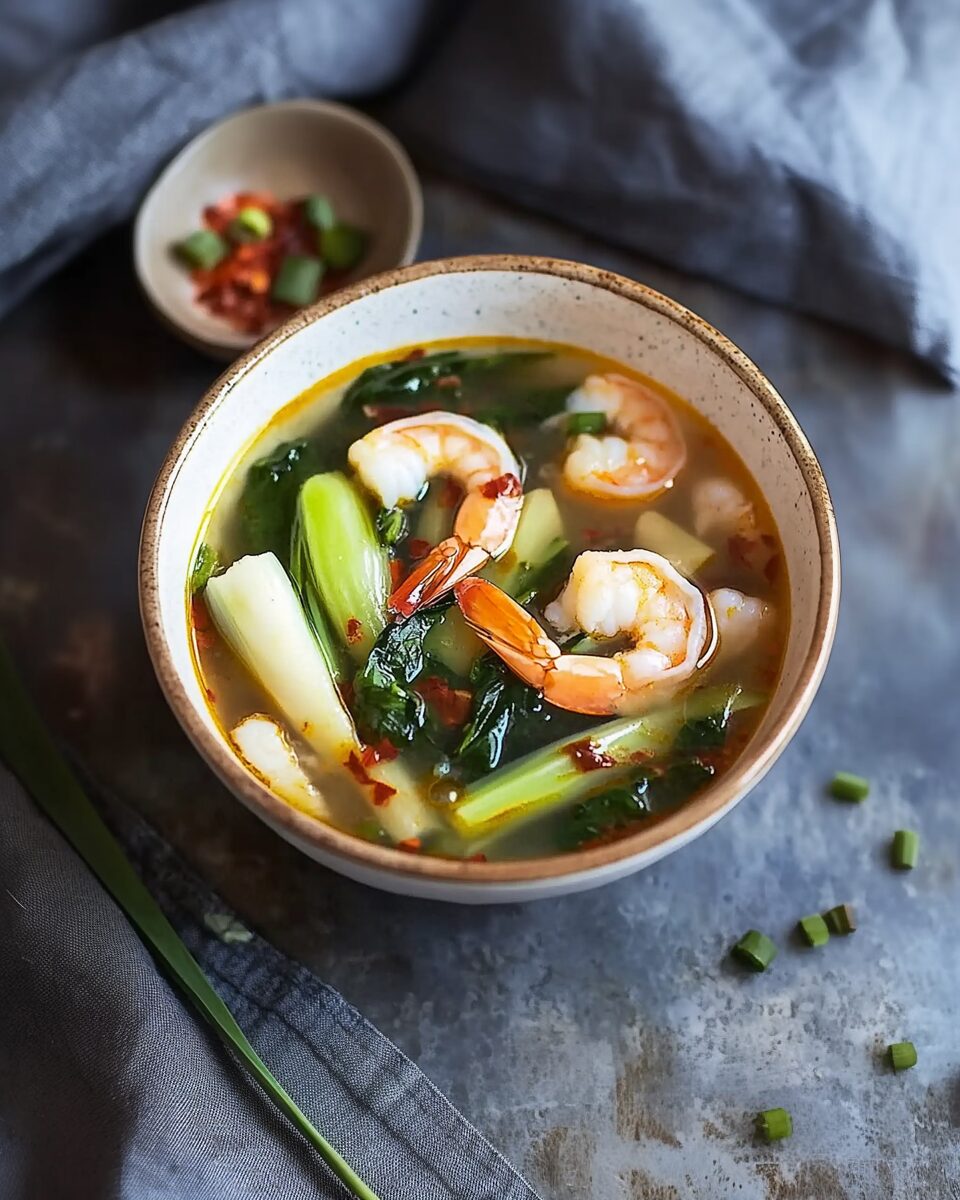This Healthy Bok Choy Cabbage Shrimp Soup is a quick, flavorful, and nutritious meal, perfect for a hassle-free dinner. Combining tender shrimp with fresh bok choy in a savory broth, this soup offers a delightful blend of textures and tastes. It’s an excellent choice for those seeking a light yet satisfying dish.
Full Recipe:
Ingredients
-
4 cups (1 liter) water
-
1 bok choy cabbage (or substitute with Swiss chard, other greens, or frozen peas)
-
8 raw prawns (frozen are acceptable)
-
1 shallot
-
2 spring onions, sliced
-
2 garlic cloves, finely chopped
-
1 knob of fresh ginger, peeled and sliced
-
2 small red chilies
-
A handful of coriander leaves
-
3 tablespoons Nuoc Mam sauce (or any fish sauce)
-
Juice of ½ lemon, plus lemon wedges for garnish
-
3 tablespoons neutral oil (such as corn or sunflower oil)
Directions
-
Remove the prawn heads and shells; devein the prawns by running a knife down their backs and extracting the digestive thread.
-
In a large saucepan over high heat, warm 3 tablespoons of oil. Add the prawn heads and shells, then stir-fry with the garlic and shallot for about 3 minutes until they turn pink.
-
Pour in the water and add the chilies, ginger, and coriander leaves. Bring the mixture to a simmer and let it cook for 20 minutes to develop the broth’s flavor.
-
Strain the broth to remove the solids, returning the clear liquid to the saucepan. Stir in the fish sauce and lemon juice, then bring the broth back to a boil.
-
Add the bok choy to the boiling broth and cook for 2 minutes. Introduce the prawns and continue cooking for another 2 minutes, ensuring the bok choy remains crisp and the prawns are cooked through.
-
Adjust the seasoning to your preference. Serve the soup hot, garnished with sliced spring onions and accompanied by lemon wedges.
Nutrients (Per Serving, based on 2 servings)
-
Calories: Approximately 220 kcal
-
Total Fat: 10g
-
Saturated Fat: 1.5g
-
Cholesterol: 150mg
-
Sodium: 1,200mg
-
Total Carbohydrates: 12g
-
Dietary Fiber: 3g
-
Sugars: 4g
-
Protein: 20g
Historical and Cultural Significance
The combination of seafood and leafy greens in soups has deep roots in various Asian culinary traditions. In Vietnamese cuisine, for example, cabbage and shrimp soup, known as “Canh Bắp Cải Nấu Tôm,” is a staple in family meals. These soups are typically light, served alongside other dishes, and are valued for their ability to balance flavors and textures within a meal. The inclusion of shrimp adds a delicate sweetness, while vegetables like cabbage or bok choy contribute freshness and crunch.
Bok choy itself has a rich history. Native to China, it has been cultivated for thousands of years, particularly in the Yangtze River Delta region. Over time, bok choy spread to other parts of Asia and eventually to Europe and North America through trade and migration. Its adaptability and nutritional benefits have made it a beloved ingredient in many culinary traditions.
Nutritional Benefits
Bok choy and shrimp are both nutrient-dense foods that offer numerous health benefits.
Bok Choy:
-
Vitamins and Minerals: Bok choy is rich in vitamins A, C, and K, as well as minerals like calcium, potassium, and magnesium. These nutrients support immune function, bone health, and cardiovascular health.
-
Antioxidants: The vegetable contains phytonutrients with antioxidant properties that may reduce the risk of chronic diseases, including certain cancers and heart disease.
-
Low in Calories: Bok choy is low in calories, making it an excellent choice for those aiming to maintain a healthy weight.
Shrimp:
-
High-Quality Protein: Shrimp provides a lean source of protein, essential for muscle maintenance and repair.
-
Omega-3 Fatty Acids: These fatty acids support heart health and have anti-inflammatory properties.
-
Vitamins and Minerals: Shrimp is a good source of vitamin B12, iodine, and selenium, which are important for energy production, thyroid function, and antioxidant defense.
Combining these ingredients in a soup results in a dish that is both nourishing and satisfying.
Variations Across Cuisines
The versatility of bok choy and shrimp allows for a variety of interpretations across different culinary traditions.
Vietnamese Cuisine:
In Vietnam, cabbage and shrimp soup is a common dish in family meals. Known as “Canh Bắp Cải Nấu Tôm,” this soup is typically light and savory, often served alongside other dishes to balance flavors and textures. The shrimp are often marinated and pounded thin to enhance their texture, and the soup is garnished with green onions and black pepper for added flavor.
Chinese Cuisine:
In Chinese cooking, bok choy is frequently paired with seafood in soups and stir-fries. The mild flavor of bok choy complements the sweetness of shrimp, and ingredients like ginger, garlic, and soy sauce are commonly used to enhance the dish’s depth. Variations may include the addition of mushrooms, tofu, or noodles to create a more substantial meal.
Fusion and Contemporary Interpretations:
Modern takes on bok choy and shrimp soup often incorporate elements from various cuisines. For instance, adding turmeric can introduce anti-inflammatory benefits and a vibrant color to the broth. Including noodles, such as rice noodles or soba, can transform the soup into a hearty main course. These adaptations showcase the dish’s flexibility and its ability to evolve with culinary trends.
Preparation Tips
Creating a flavorful and well-balanced bok choy cabbage shrimp soup involves attention to detail in preparation.
-
Selecting Ingredients: Choose fresh, firm bok choy with vibrant green leaves and crisp stalks. For shrimp, opt for fresh or properly thawed frozen shrimp, ensuring they are deveined and cleaned thoroughly.
-
Building the Broth: A rich, aromatic broth forms the foundation of the soup. Sautéing aromatics like garlic, ginger, and shallots before adding liquid can enhance depth of flavor. Using homemade or high-quality store-bought broth can also make a significant difference.
-
Cooking Sequence: Add ingredients to the broth based on their cooking times. Bok choy should be added towards the end to maintain its crispness, while shrimp should be cooked just until pink to prevent toughness.
-
Seasoning: Balance the flavors with a combination of salty, sour, and umami elements. Fish sauce, soy sauce, and a squeeze of fresh lemon or lime juice can elevate the taste profile. Adjust seasoning gradually, tasting as you go.
Serving Suggestions
Bok choy cabbage shrimp soup can be enjoyed in various contexts, from a light starter to a main course.
-
Accompaniments: Serve the soup with steamed rice or a side of crusty bread to create a more filling meal.
-
Garnishes: Top the soup with sliced green onions, fresh cilantro, or a sprinkle of chili flakes for added flavor and visual appeal.
-
Presentation: Use deep bowls to serve the soup, ensuring each portion contains a generous mix of shrimp and bok choy.
Conclusion
Bok choy cabbage shrimp soup exemplifies the harmony of simple ingredients coming together to create a dish that is both nourishing and flavorful. Its roots in various Asian culinary traditions highlight its cultural significance, while its adaptability allows for creative interpretations to suit modern palates. By understanding the nutritional benefits, regional variations, and preparation techniques, one can appreciate the depth and versatility






